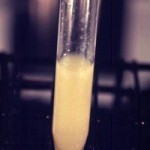Urine color
The color of the urine sample is assessed visually and reported as red, brown, yellow, etc, or combination thereof, along with a modifier for the depth of color, eg, light yellow, dark red/brown, etc. Some examples of various urine colors and corresponding common causes are shown below (this is not an exhaustive list – there are many other substances, including drugs, which can influence urine color). In addition, color is quite subjective and dependent on observer. For example, bilirubin can look green or brown, depending on the observer. Urine color partly correlates to urine specific gravity (USG), with increasing intensity of yellow being associated with increased median USG in canine urine, i.e. clear to slightly yellow urine has a median USG of 1.013 (all tested urine samples had a USG <1.030), whereas dark yellow urine had a median USG of 1.041, but the USG of the different categories of urine color did overlap (clear, light yellow, medium yellow, dark yellow) (Cridge et al 2018).
| Possible causes** | |
| Light to medium yellow | Normal |
| Colorless | Dilute urine (USG < 1.030) |
| Dark yellow | USG > 1.020 in most animals |
| Very dark yellow | Concentrated urine (USG likely > 1.030), bilirubinuria. |
| Red to brownish-red | Hematuria; hemoglobuinuria; myoglobinuria; pyrocatechol (oxidizing agent in horse urine which can turn it red) |
| Reddish-brown to brown | Myoglobinuria, hemoglobinuria (methemoglobin), lots of calcium carbonate crystals in urine of horses (these crystals are brown-tinged; crystals will sediment on centrifugation) |
| Greenish tint | Bilirubinuria, biliverdin (birds and reptiles) |
| * Subjective and observer-dependent ** Not an exhaustive list. |
|
Urine turbidity
The turbidity of the urine sample is gauged subjectively and reported using the descriptors: clear, slightly cloudy, cloudy, opaque, or flocculent.
Normally, fresh urine is clear to very slightly cloudy. Excess turbidity results from the presence of suspended particles in the urine. The cause can usually be determined based on the results of a microscopic urine sediment examination.

Common causes of abnormal turbidity
- increased cells (RBC, WBC)
- numerous crystals
- bacteria
- lipiduria (lipids often rise to the surface)
- mucus (especially in horses)
- semen
- fecal contamination
